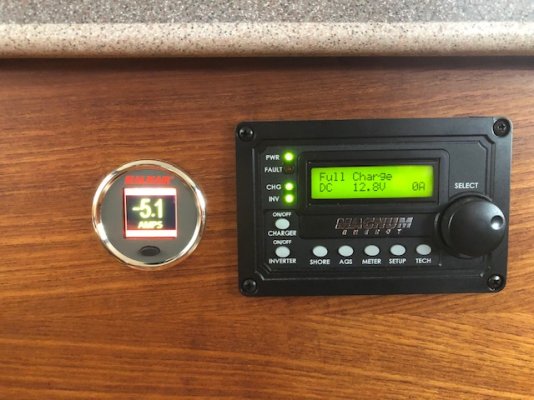I think some of you are confusing the first (older) version of the Balmar Smartguage with the newest version the SG200. The new version DOES HAVE A SHUNT and measures "instantaneous current"! It is way easier to setup than a more traditional monitor and is more accurate (especially if the user does not adjust the monitor over time - which is not needed with the Balmar unit), plus it provides information about the overall condition (based on age and useage) or state of health of your batteries.
Disclaimer: I have no affiliation with Compass Marine, Balmar, etc. I just want to set the record straight and inform the OP (Tom) of this potentially better option. Admittedly, "better" is a matter of opinion.
I agree with earlier posts about what is "useful information" about your batteries, but some of the statements made about what the monitor must have or be capable of to achieve this is no longer correct (due to changing technology).
I have the older version of the Balmar. It does not have a shunt. It works great for me. It tells me voltage and state of charge very, very accurately. My charger remote panel tells me what voltage and how many amps are being input by that device, and my solar charge controller tells me even more info about what the panels are doing. If I was interested, I could calculate amp hours based on the "state of charge", but I find the percentage far easier to understand as for me it is used to decide if I need to run the generator to top up the batteries. If I do run the gen set, then I use the state of charge percentage coupled with the charger remote panel (which tells me input amperage) to decide when I have reached the point of diminishing returns for shutdown.
The newer version (of the Smartgauge) provides what I have described plus instantaneous current, and state of health (a percentage of what your battery is now capable of compared to the baseline of what a new battery is capable of). So for example, if your battery bank now is only capable of 80% of what it could hold when new, it informs you of this fact. As well, your state of charge now reflects this new, diminished capacity so you will not accidentally discharge below the (new) 50% mark, potentially damaging your already aged batteries. I don't know why this capability is something some of you have vehemently stated you don't want?
Anyway, my intent is only to inform about what for some may be "new developments", but still believe, "to each his own"


